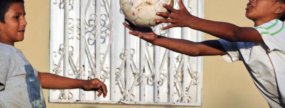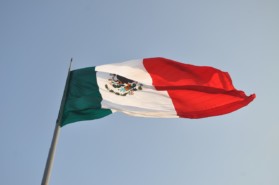Posted on 24 Nov 2015
At about 21:00 local time on Thursday 19 November 2015, a man was executed in his home in rural Peru, shot three times while attempting to retrieve the gun he kept in his house for protection. His name was Alfredo Ernesto Vracko Neuenschwander, and he was 58 years old. The Global Initiative against Transnational Organized Crime expresses its most sincere condolences to Mr. Vracko’s family and friends, as well as all others touched by this tragedy.
Don Alfredo, as he was known to many of his friends, had dedicated his life to defending the Peruvian Amazon. He received several land and forest concessions from the government, including a rare reforestation concession. But Don Alfredo’s activism did not stop at the forest’s edge. Living only a few kilometers from the settlement of La Pampa, the epicenter of illegal gold mining in Peru, Don Alfredo had taken it upon himself to try to spur the government of Madre de Dios state to take action against the miners. Beginning in 2007, he lodged countless complaints with the government, none of which were ever acted upon. In the weeks and months before his murder, Don Alfredo told friends that he had begun to fear for his safety, and that he was receiving regular death threats.
Sadly, the case of Don Alfredo is not an isolated one. Peru enjoys abundant natural resource deposits: it is the world’s third-largest producer of both copper and zinc, as well as being a major source of gold, silver, and many other commodities. Many of the richest mines, though, are located in the Peruvian Amazon (such as the La Pampa area) or other biodiversity “hotspots” like the Tambopata Reserve. Environmentalists and conservationists have long expressed concern about the potential costs of mining in Peru’s rainforests, which include increased carbon dioxide emissions, deforestation, and the destruction of habitats for, or even extinction of, plants and animals.
But there is another aspect to this problem, one which Don Alfredo’s tragic death makes all too clear. Illegal mining is big business in Peru. Observers have estimated that anywhere from half to 97% of the 18 tons of gold produced each year in Madre de Dios state (one-tenth of the country’s total production) is mined illegally; based on a price of US$1,073.03 per ounce, that would mean that Madre de Dios state alone produces US$283-550 million worth of illegal gold per year. The trade in illicit gold may even be more valuable than the cocaine trade, and it deprives the Peruvian government of an estimated US$305 million annually. Moreover, in a 2013 publication, the investigative organization Verité reported that illegal gold mining in Peru is closely intertwined with many other forms of criminal activity, including sexual exploitation, human trafficking, forced labor, and child labor.
With hundreds of millions of dollars per year at stake, it is perhaps unsurprising that Peru’s illegal mining organizations might employ violence to protect their operations. Don Alfredo’s murder is the first known instance of a mining activist being killed in Peru, but violence linked to the illicit mines has been commonplace for years. In some cases, the violence has occurred when local miners have protested against new laws that attempt to crack down on the booming trade. Far more common, however, are turf wars or other conflicts between mining syndicates, and academic studies in neighboring countries, including Colombia, have found statistically significant correlations between illegal mining activity and murder rates. In order to shed further light on this topic, the Global Initiative will be releasing a study in December that presents a comparative analysis of illegal mining, and the illicit industries linked to it, across Latin America.
While Don Alfredo may have been the first mining activist to be murdered in Peru, he is far from the first environmentalist to die for his or her cause. Between 2002 and 2014, according to Global Witness, 57 environmental or land-rights activists were killed in the country. In 2014, Peru suffered the fifth-most murders of such activists of any country in the world, with its total of 9 deaths trailing only Brazil, Colombia, the Philippines, and Honduras. The threat to Peruvian activists is increasing, with 60% of the 57 murders identified by Global Witness between 2002 and 2014 occurring during the last four years of that time span. Unfortunately, this is a reflection of a global trend: three times as many people were killed protecting the environment or their land rights in 2012 as in 2002.
Might Don Alfredo’s death serve as a catalyst for change? There are, perhaps, reasons to be hopeful. Don Alfredo’s son, Freddy Vracko Metzger, is running for Congress in Peru’s upcoming elections, where he might be able to lead new action against illegal mining. On a less tangible level, those who have sought to fight illegal mining in Peru have traditionally done so in the arena of policy and discourse, while those trying to protect the rainforests have focused more on action on the ground. Given that Don Alfredo was a widely-known and respected figure in both of these camps, his death may be the impetus for further coordination and unification among Peruvian activists across all issues.
For now, though, activists and citizens in Peru and across the world are mourning the loss of a leader, an inspiration, and a friend.
_________________________
Morir por una causa: en memoria de Alfredo Ernesto Vracko Neuenschwander
Imagen: Luego de una redada en un campamento minero de oro en La Pampa, Perú. (Crédito: Dante Piaggio, El Comercio)
Cerca de las 21:00 horas del jueves 19 de noviembre de 2015, un hombre fue asesinado en su propia casa en una zona rural de Perú. Recibió tres disparos mientras intentaba ir tras la pistola que guardaba en su casa para protegerse. Su nombre era Alfredo Ernesto Vracko Neuenschwander y tenía 58 años. The Global Initiative against Transnational Organized Crime quiere expresar sus condolencias a los familiares y amigos del señor Vracko, y a todos los que han sido tocados por esta tragedia.
Don Alfredo, como lo llamaban muchos de sus amigos, había dedicado su vida a defender el Amazonas peruano. Recibió varias concesiones de tierras y bosques del gobierno, incluyendo una extraña concesión de reforestación. Pero el activismo de Don Alfredo no terminaba en los bosques. Vivía a unos pocos kilómetros en un sector conocido como La Pampa, el epicentro de la minería ilegal en Perú, y se había entregado a la tarea de intentar impulsar al gobierno de Madre de Dios a tomar acciones contra los mineros. Desde comienzos de 2007, había presentado un sinfín de reclamos ante el gobierno, los cuales nunca fueron escuchados. En las semanas y meses previos a su muerte, Don Alfredo les confesó a sus amigos que había comenzado a temer por su seguridad, y que estaba recibiendo amenazas de muerte con bastante frecuencia.
Lamentablemente, el de Don Alfredo no es un caso aislado. Perú goza de abundantes depósitos de recursos naturales: es el tercer mayor productor de cobre y zinc, y también una importante fuente de oro, plata, y muchos otros recursos. Muchas de las minas más ricas están ubicadas en el Amazonas peruano (como la zona de La Pampa) o en otros sitios con gran biodiversidad, como la Reserva de Tambopata. Desde hace mucho tiempo, ambientalistas y activistas por la conservación vienen expresando su preocupación sobre los costos potenciales de la minería en los bosques peruanos, que incluyen mayores niveles de emisión de dióxido de carbono, deforestación, y la destrucción de hábitats de plantas y animales, y hasta incluso su extinción.
Pero hay otro aspecto a observar, uno que la muerte trágica de Don Alfredo muestra claramente. En Perú, la minería ilegal es un gran negocio. Los observadores estiman que entre el 50% y el 97% de las 18 toneladas de oro producidas anualmente en el estado de Madre de Dios (un décimo de la producción total del país) proviene de la minería ilegal. Basándonos en un precio de US$1.073,03 por onza, significaría que sólo el estado de Madre de Dios produce US$283-550 millones de oro ilegal por año. El comercio ilícito de oro puede incluso ser más valioso que el de cocaína, y priva al gobierno peruano de unos US$305 millones anuales. Además, en una publicación de 2013, la organización de investigaciones Verité informó que la minería ilegal en Perú se entrelaza con muchas otras actividades clandestinas, incluyendo la explotación sexual, el tráfico de personas, el trabajo forzado, y la explotación de menores.
Con cientos de millones de dólares anuales en juego, tal vez no sorprende que las organizaciones mineras ilegales de Perú puedan emplear la violencia para proteger sus operaciones. El de Don Alfredo es el primer caso que se conoce en Perú sobre un asesinato a un activista, pero la violencia ligada a la minería ilegal ha sido un lugar común durante años. En algunos casos, la violencia se dio cuando mineros locales protestaban en contra de nuevas legislaciones que intentaban tomar medidas duras contra el creciente comercio. No obstante, son mucho más frecuentes las disputas territoriales u otros conflictos entre grupos mineros, y estudios académicos en países vecinos, incluyendo a Colombia, han revelado correlaciones estadísticamente relevantes entre la actividad minera ilegal y la tasa de asesinatos. Con la intención de arrojar más luz sobre este asunto, Global Initiative estará presentando en diciembre una estudio que presenta un análisis comparativo de la minería ilegal y las industrias ilícitas ligadas a ellas en toda América Latina.
Aunque Don Alfredo pueda ser el primer activista contra la minería asesinado en Perú, está lejos de ser el primer ambientalista en morir por su causa. Entre 2002 y 2014, según Global Witness, 57 ambientalistas o activistas por los derechos sobre la tierra fueron asesinados en el país. En 2014, Perú fue el quinto país a escala mundial con el mayor número de asesinatos a activistas, totalizando 9 muertes; por delante se ubicaron Brasil, Colombia, Filipinas, y Honduras. La amenaza sobre los activistas peruanos viene en alza – el 60% de los 57 asesinatos identificados por Global Witness entre 2002 y 2014 ocurrieron sólo durante los últimos cuatro años. Desafortunadamente, este es un reflejo de una tendencia global: en 2012 el número de personas asesinadas por proteger el medio ambiente o sus derechos sobre la tierra se triplicó respecto de 2002.
¿Podrá la muerte de Don Alfredo servir como disparador de un cambio? Quizás existen razones para creer que sí. El hijo de Don Alfredo, Freddy Vracko Metzger, se presenta para las elecciones parlamentarias en Perú en las próximas elecciones, en donde tal vez pueda liderar alguna nueva acción contra la minería ilegal. En un nivel menos tangible, aquellos que han intentado luchar contra la minería ilegal en Perú lo han hecho tradicionalmente en el terreno de políticas y discursos, mientras que aquellos que han intentado proteger los bosques se han enfocado más sobre acciones en el terreno. Dado que Don Alfredo era una figura muy conocida y respetada en ambos campos, su muerte puede dar un impulso a una mayor coordinación y unificación entre los activistas peruanos de todos los sectores.
Por el momento, activistas y ciudadanos en Perú y en todo el mundo se lamentan por la pérdida de un líder, un inspirador, y un amigo.



